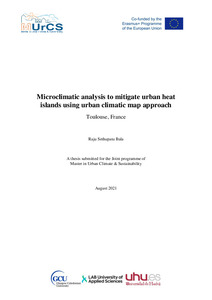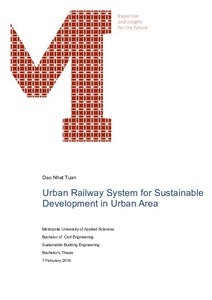Microclimatic analysis to mitigate urban heat islands using urban climatic map approach : Toulouse, France
Sethupatu Bala, Raju (2021)
Sethupatu Bala, Raju
2021
All rights reserved. This publication is copyrighted. You may download, display and print it for Your own personal use. Commercial use is prohibited.
Julkaisun pysyvä osoite on
https://urn.fi/URN:NBN:fi:amk-2021110119133
https://urn.fi/URN:NBN:fi:amk-2021110119133
Tiivistelmä
Cities are urbanising at a fast phase to accommodate more people, which leads to global and local warming. Due to urbanisation, European cities are facing summer heatwave issues. The air temperature reaches up to 40 degrees celsius during the summer heatwave in Toulouse, France. Since the urban infrastructures are responsible for climatic issues, it is essential to inform urban planners and urban designers about it. Urban climatic maps are used to inform urban planners and designers about various urban climatic issues. But, urban planners and designers are not able to make appropriate climate responsive decisions based on the climatic information available through urban climatic maps. This is because the maps do not provide information about the urban planning and design parameters that cause the climatic issue in the city. To bridge the gap, this thesis aims to provide complementary spatialized indicators useful for climate-responsive decisions. Toulouse was chosen to build the climatic maps, and UHI is the climatic issue-focused through this thesis. This thesis is conducted in three phases. In the first phase, 17 urban planning and design indicators were identified through qualitative research methods. In the second phase, various GIS tools were explored to calculate the identified indicators, to build the urban climatic maps. The data generated under the MApUCE project, for Toulouse, was used to calculate the identified indicators. In the last phase of the research, the calculated indicators were grouped, and Geographically Weighted Regression (GWR), a local regression method, was used to find the relationship between the identified indicators and the climatic issues. Compared to the Ordinary Linear Regression (OLS), a global regression, GWR provides more spatial heterogeneity. Based on the GWR results, the indicators that are most responsible for the UHI effect around the city centre of Toulouse were identified. Since this region experiences the most summertime discomfort, it was selected to show how the results can be used for urban planning and design decisions. Overall this thesis demonstrates an urban climatic map approach that will be useful for the urban planning and design community. The indicators identified in this thesis can be used for future urban climatic research.
Kokoelmat
Samankaltainen aineisto
Näytetään aineisto, joilla on samankaltaisia nimekkeitä, tekijöitä tai asiasanoja.
-
Urban Railway System for Sustainable Development in Urban Area
Nhat Tuan, Dao (Metropolia Ammattikorkeakoulu, 2019)The aim of this thesis was to study an urban railway system for sustainable development of a metropolitan area. The thesis studied a basic type of municipal railway and its implementation by, first, studying two well-developed ... -
Mapping Thermal Hotspots in Malé, Maldives : Assessing the Relationship Between Urban Heat Islands, Climate, and Heat Risk for Sustainable Urban Planning
Hameed, Aminath Maiha (2023)This study aims to support climate-conscious urban development in greater Male’, Maldives, based on characterizations of the local microclimate. It explores intra-urban temperature variations, identifies heat risks and ... -
Assessing the Influence of Urban Form on the Cooling Impacts of Urban Parks : A Case Study in Glasgow
Lelei, Najma Yusuf (2023)Urban Heat Island (UHI) effect has been a growing concern in the UK; therefore, the mitigation of such effects would contribute to sustainable urban development. A review of literature indicates that green infrastructure ...



